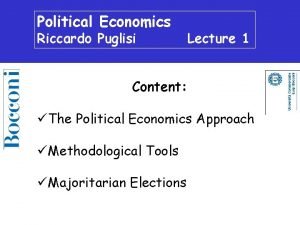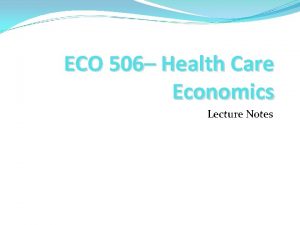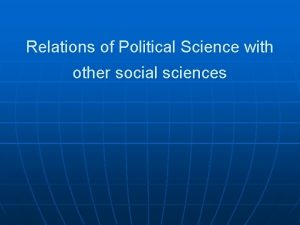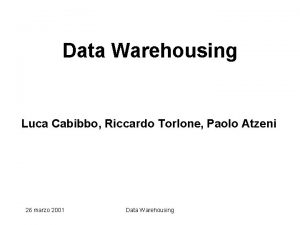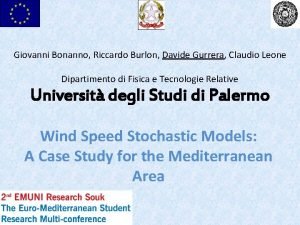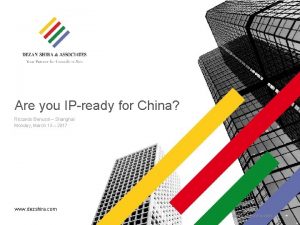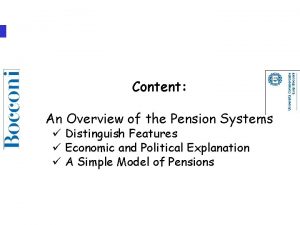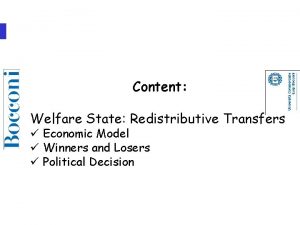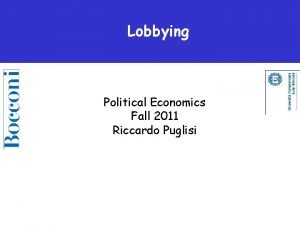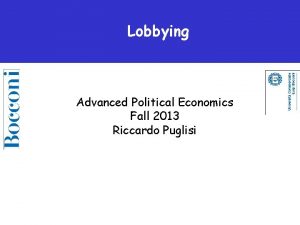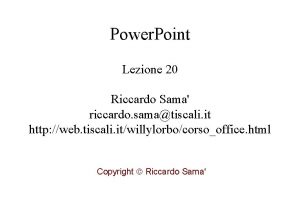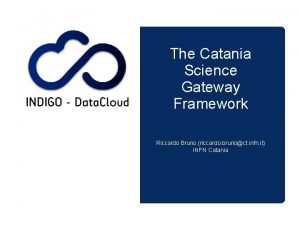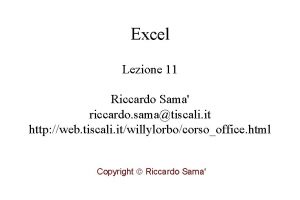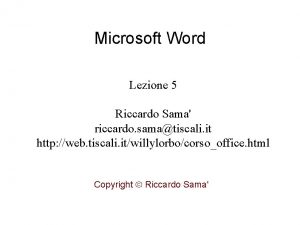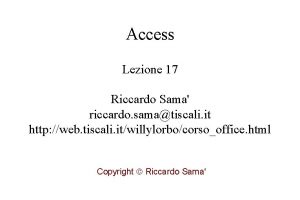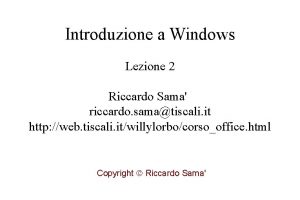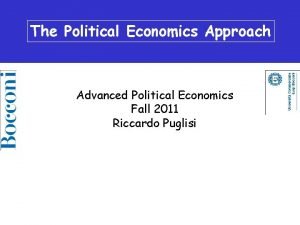Political Economics Riccardo Puglisi Lecture 1 Content The


















- Slides: 18

Political Economics Riccardo Puglisi Lecture 1 Content: üThe Political Economics Approach üMethodological Tools üMajoritarian Elections

The Political Economics Approach Individual Preferences over Economic Policy POLITICAL INSTITUTIONS MARKET Economic Policy Ø Focus on the Welfare State Ø Analyze how Political Institutions affect Economic Policies

Novelty of this approach Individuals as ECONOMIC and POLITICAL Agents: Ø ECONOMIC Agents take Labor, Savings, Consumption Decisions Ø POLITICAL Agents (Voters) decide over Economic policies (Redistribution, Public Goods, etc) Economic Agents Markets Economic Aggregates & Prices Political Agents Political Institutions Economic Policy POLITICO-ECONOMIC EQUILIBRA

Ø Economic Agents maximize their Utility Function (or their profit) w. r. t. an economic variable, subject to some constraints, given the economic policy Example: Given the retirement programs, workers decide when to retire ECONOMIC BEHAVIOUR Ø Political Agents (Voters) maximize their “indirect Utility Function” w. r. t. the economic policy under consideration Example: Given their age, occupation, health status and savings elderly workers decide which early retirement policy they prefer VOTING BEHAVIOUR

OUR GOALS 1. Explain the Rise and Sustainability of different configurations of the WELFARE STATE: ü ü Use a simple political institution to aggregate preferences Find “economic” or demographic explanation of the differences 2. Analyze the Impact of Different POLITICAL INSTITUTIONS on ECONOMIC POLICIES ü ü Examine Political Regimes and Electoral Rules Economic Policy, Corruption, Political Accountability

METHODOLOGICAL TOOLS • How are Individual Preferences over an Economic Policy Aggregated in Actual Economic Policy? POLITICAL INSTITUTIONS If political institutions were neutral: Ø No effect on Economic policy Ø Different Economic Policy explained only by Economic, Demographic, Sociological Differences

However…. Political Institutions are not neutral: Ø ARROW’S IMPOSSIBILITY THEOREM Ø EXAMPLE OF NON-NEUTRALITY IN ELECTIONS Ø MAJORITARIAN ELECTIONS: THE MEDIAN VOTER THEOREM

ARROW’S IMPOSSIBILITY THEOREM Arrow (1951) showed that there is NO DEMOCRATIC mechanism which allows individual preferences to be aggregated in a consistent way, that is, so that the following properties are satisfied: (1) RATIONALITY (aggregate preferences are complete and transitive) (2) UNRESTRICTED DOMAIN (on individual preferences) (3) WEAK PARETO OPTIMALITY (4) INDIPENDENCE (from irrelevant alternatives) In Political Economics, we usually drop property (2)

Example of Non-Neutrality in Elections • Consider 7 Voters(1, 2, 3…. , 7) and 4 Alternatives Policies (A, B, C, D) • Analyze 3 types of elections: Ø PLURALITY (or MAJORITY) voting Ø VOTING between two alternatives with AGENDA setting Ø “BORDA” voting

Alternatives Agents 1 2 3 4 5 6 7 best A A A B B C C B B B C C D D C C C A D A A D D A B B worst A = 3 votes 1) MAJORITY/PLURALITY voting: B = 2 votes A winner C = 2 votes 2) VOTING between two alternatives Ø AGENDA I a vs b -- vs c -- vs d C winner Ø AGENDA II d vs c -- vs b -- vs a A winner ØAGENDA III a vs c -- vs b -- vs d B winner

Alternatives Agents 1 2 3 4 5 6 7 best A A A B B C C B B B C C D D C C C A D A A D D A B B worst 3) “BORDA” voting (k = 1): 1 vote to the first MAJORITY VOTING A winner A = 6 votes (k = 2): 2 votes to the first, 1 vote to the second B = 7 votes C = 6 votes D = 2 votes B winner

Why do different voting procedures reach different results? Individual preferences are not SINGLE-PEAKED best agents 1, 2, 3 agent 4 agent 5 agents 6, 7 worst A B C D Do single-peaked preferences make sense for economic policy problems?

POLITICAL INSTITUTIONS üElectoral Models Ø Electoral Competition between two Candidates (Median Voter) Ø Probabilistic Voting (Dixit - Londregan, 1996) Ø Citizen Candidate (Besley - Coate, 1997, Osborne - Slivinski, 1996) ü Legislative Models (Post-Electoral Politics) Ø Agenda Setting (Baron - Ferejohn, 1998) Ø Allocation of Policy Jurisdiction (Shepsle, 1979) ü Lobbying Models (Becker, 1983, Grossman - Helpman, 1994) Additional Dichotomy on the MOTIVATION of politicians: Opportunistic (office or rent-seeking) or Partisan

MAJORITARIAN ELECTIONS Main Features: Ø Direct democracy: voters choose a one-dimensional economy policy (e. g. the size of the welfare state, degree of flexibility in the labor market) Ø Each voter has single-peaked preferences over the economic policy Ø Bliss point: most preferred economic policy Ø Median voter divide the distribution of votes in half Ø Commitment over economic policy

MEDIAN VOTER THEOREM If preferences are single-peaked along a one-dimensional economic policy, the median voter’s bliss point represent the equilibrium outcome of the majoritarian voting game Ø Intuition: All voters to the left of the median voter – i. e. , whose bliss point is lower than the median voter’s – prefer the median voter’s (MV’s) bliss point to any point chosen by voters to the right of the median voter, and vice versa. Ø Hence, 50% of the voters prefer the MV’s bliss point to any lower level [the voters to the right of the MV]. While 50% prefer the MV’s bliss point to any higher level [voters to the left of the MV]

MEDIAN VOTER THEOREM U A B xa X’ C X* xc • B is the median voter • x* is the equilibrium outcome of the voting game x

Applications of the Median Voter Theorem • Election: majority voting for political candidates (or parties) • Two opportunistic candidates who chose political platform (or ideology) • Voters care about the ideology/political platform • Political outcome: both candidates select as their platform the ideology of the median voter

DOWNS - HOTELLING MODEL Proportion of voters left Im Ib Ia right Ideology Ø Result: Party A & B converge towards Im - the ideology of the median voter Ø Implication: “Policy moderation” - both parties move towards moderate positions (ideology) and away from extreme ØEvidence: In two candidates (parties) systems, moderate and “similar” positions.
 Riccardo puglisi
Riccardo puglisi Riccardo puglisi moglie
Riccardo puglisi moglie Martina puglisi
Martina puglisi 01:640:244 lecture notes - lecture 15: plat, idah, farad
01:640:244 lecture notes - lecture 15: plat, idah, farad Principles of economics powerpoint lecture slides
Principles of economics powerpoint lecture slides Land use planning '' lecture notes
Land use planning '' lecture notes Health economics lecture notes
Health economics lecture notes Real content and carrier content in esp
Real content and carrier content in esp Dynamic content vs static content
Dynamic content vs static content Relation of political science with history
Relation of political science with history Economics and business economics maastricht
Economics and business economics maastricht Elements of mathematical economics
Elements of mathematical economics Fernando pavarotti
Fernando pavarotti Riccardo torlone
Riccardo torlone Riccardo burlon
Riccardo burlon Riccardo benussi
Riccardo benussi Riccardo sartori psicologo
Riccardo sartori psicologo Riccardo dominici
Riccardo dominici Riccardo marangon
Riccardo marangon
